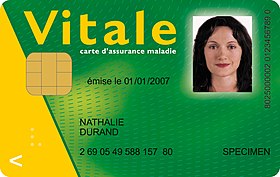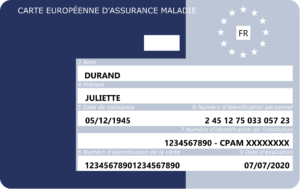Carte Vitale is a famous green card you need to have if living in France, as it gives you access to the French healthcare system. If you thought your residency card was the most important card to get in France, the Carte Vitale is a close second. So, how do you get a Carte Vitale and what is it used for?

What is Carte Vitale and how do you get it?
It is a physical smartcard (it has a chip like a bank card) that allows you to obtain health insurance reimbursements more quickly and much more easily. Thanks to it, the government and your private health insurer receive all the information necessary to reimburse your medical expenses. To do this, the healthcare professional inserts the Carte Vitale into a terminal, which transfers your data to Social Security and informs them of the cost they must reimburse you.
Within a few days and without any action, you will automatically receive reimbursement for the healthcare costs you have incurred. The Carte Vitale and the digital reimbursement process it facilitates aims to replace the frustrating, confusing and time-consuming process of asking for paper care forms (feuilles des soins), filling them out by hand, and mailing them in.
Example of how Carte Vitale works
The French Social Security system (“Sécu“) provides state healthcare coverage, generally covering about 70% of essential and emergency healthcare. Let’s say you need to visit the doctor, which costs €50. At the end of the appointment, you will first give the doctor your Carte Vitale and then pay them €50 for your visit. Sécu will reimburse you 70% of the €30 basis defined, or €21. To mitigate potential overconsumption, Sécu charges you a €1 fee if you are over 18 years old for any healthcare treatment you receive that they cover. So actually, your reimbursement from them will be €20 rather than €21. This example leaves €30 to be paid by you for the consultation. If you have a private health insurer (mutuelle), they will reimburse you for some or all of the €30 amount you owe, based on your specific coverage plan.
What information does Carte Vitale hold?
It contains all the information necessary for the French government to reimburse you for their share of your health costs and care.
Thanks to your Carte Vitale card, your doctor will know the following:
- Your identity and your beneficiaries;
- Your Social Security number;
- The health insurance plan and fund to which you’re attached;
- The details of any supplementary health insurance (through your employer or privately);
- History of your care and prescriptions (accessible by a doctor only with your consent);
- Your bank account details to which their reimbursements should be sent.
What happens if you go to the doctor and forget to bring your Carte Vitale?
Don’t worry; you can still go to see your doctor even if you’ve forgotten or lost the card. You just need to ask your doctor for a care form (feuille des soins) and send it by post to Caisse Primaire d’Assurance Maladie (“CPAM“) to be reimbursed. You have a maximum of 2 years to send it to your CPAM and get refunded. This waiting game for reimbursement is a real pain, so remember to bring your Carte Vitale to your doctor appointments!
How to apply for a Carte Vitale
You can only apply for a Carte Vitale once you’ve received your all-important French Social Security number. Once you have it, the simplest and quickest way to get your Carte Vitale is to apply for it via the Ameli website.

Step 1: Create an Ameli account
Ameli is a secure health insurance platform for policyholders. It allows you to do many things related to your healthcare, including ordering your Carte Vitale, consulting your medical payments and reimbursements, etc.
If you do not yet have an Ameli account, you must create one to apply for a Carte Vitale. Log onto the Ameli website, then click on “Create an account” (“Créer un compte”). Then provide the requested information (Social Security number, name, address, etc.). You must not forget to attach your bank identity statement (RIB) for your reimbursements. You can also download the mobile application of the Ameli account to manage everything on the go.
Step 2: Order Carte Vitale from your Ameli account
Request your first Carte Vitale
From your Ameli account, go to “My procedures” (“Mes dèmarches“), select “Ma Carte Vitale” and “Commander ma Carte Vitale“. If there is more than one beneficiary displayed, choose the name of the person requesting to order the card. The Carte Vitale application continues by uploading a scanned ID document and ID photo.
You will get your Carte Vitale within about two weeks, accompanied by a paper copy of its information.
Adding a child to parents’ Carte Vitale
Children and young people under 16 can be registered on the Carte Vitale of one or both parents.
To add a child to your Carte Vitale, fill in the form S3705 “Demande de rattachement des enfants mineurs à l’un ou aux deux parents assurés“. Afterwards, send it by mail to your local CPAM office together with copies of the relevant birth certificate.
You can also register your child directly from the Ameli account of the parent who already has the child on their Carte Vitale. To do this go to Section “Mes démarches” and“Inscrire votre enfant sur la carte Vitale de l’autre parent“.
Order your European Health Insurance Card

Once you have your French Social Security number, you should also order a European Health Insurance Card (“EHIC“). You can do this directly from your online Amelie account. It’s really useful if you travel to other countries in the EU for holidays or business trips, and require any medical treatment while you’re there.
What is EIHC?
The European Health Insurance Card (“EHIC“) grants you access to the public healthcare system of the EU member state you’re in, on the same terms as the country’s own citizens. If the host country provides free healthcare to its residents, it will also be free for EHIC holders from France.
Should you require medical care that isn’t covered by the host country’s healthcare system, you will be required to pay for it upfront. EHIC does not serve as a method of payment, nor does it exempt you from paying these upfront fees. To seek reimbursement, you must provide proof of expenses upon returning to France through your Ameli account. It’s essential to note that EHIC cannot substitute travel insurance and will not cover any private healthcare costs in the country you’re visiting.
EHIC ensures that you have access to medically necessary treatment, allowing you to receive the care you need without having to cut short your stay in the host country and return to France.
All family members can apply to have their own EHIC, including children under 16 years old. Remember to request EHIC at least 20 days before your planned departure for it to be valid. Once activated it’s valid for two years and you can renew it afterwards in the same way via your Ameli account.
Where can you use EIHC?
EU nationals can use EHIC for medical treatment across all EU member states, as well as in Denmark, Iceland, Liechtenstein, Norway, and Switzerland.
Non-EU nationals legally residing within the EU and covered by a state social security scheme are also eligible for EHIC. However, it’s important to note that nationals from non-EU countries do not have EHIC coverage in Denmark, Iceland, Liechtenstein, Norway, and Switzerland, even if they are legal residents within an EU state.
So, there you have it. With your new Carte Vitale, you’re all set to have your healthcare expenses reimbursed seamlessly. Plus, having a European Health Insurance Card means you can roam freely in the EU, knowing you’re covered in case of any health-related needs. However, it’s worth mentioning that the French state healthcare system doesn’t cover the entirety of your medical costs. So, you’ll likely want to consider supplementary health insurance options to bridge the gap and ensure you’re fully protected.
Do you live in France? What has your experience been like with French healthcare and have you been surprised by the cost in comparison to your home country? Share in the comments below.



